The Shrinking Sport of Figure Skating
By: Alexa Cimino and Claire Purnell
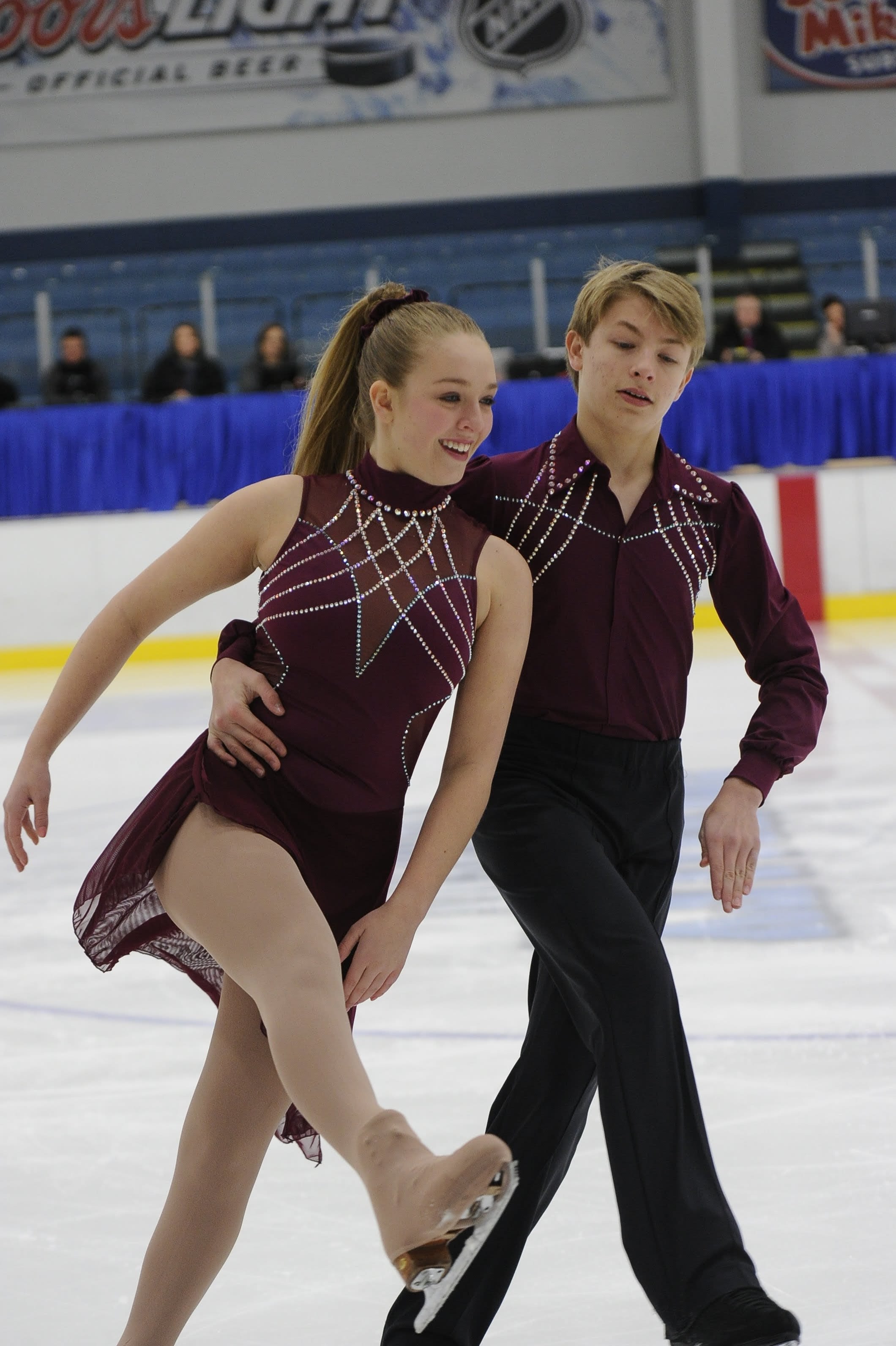
In 2017, I had the opportunity to train with Gracie Gold. As a young and fairly but not majorly successful ice dancer, I shook every time I was able to share the ice with her. However, it was not the girl I saw on TV. Instead, the national champion was a darker, heavier, scared version of the beautiful princess we saw on TV. For the first time, I saw what it was like for an athlete to truly lose themselves to a sport and not be able to hide it.
Not too long ago, U.S. figure skaters dominated the Olympic podium. From Peggy Fleming in 1968, Janet Lynn in 1972, Dorothy Hamill in 1976, to the other big names many people know today, such as Kristi Yamaguchi, Sarah Hughes, Tara Lapinski, Nancy Kerrigan, and Michele Kwan. These women were heroes, consistently winning medals and the hearts of the American public. The United States Women’s figure skating was a force to be reckoned with as they took one or more places on the podium every Olympic cycle for decades. In 2006, Sasha Cohen earned the silver medal at the Torino Olympics. The United States has not had a women figure skater on the podium at the Olympics ever since.
So what happened?
At the 2022 Winter Olympic Games in Beijing, the United States women finished in seventh, 10th and 16th place. However, the U.S. women’s medal drought was not the main focus for most people. The story of the 2022 Beijing Olympics was a 15-year-old skater from the Russian Olympic Committee, Kamila Valieva. Valieva was the first woman figure skater to land a clean quad jump in competition. The 15-year-old was expected to earn the gold medal and could have done it with her eyes closed. And she did.
Valieva performed a stunning skate in the team event, nothing less than expected. She placed first in this event before her doping results were finalized. All she had to do was perform her celebrated routine, full of quadruple jumps and perfect skating, in the individual round to earn her spot at the top of the podium. That is until she failed her drug test.
The controversy and growing international disapproval of her participation resulted in Valieva completely falling apart in her free skate. She earned fifth place and fourth overall, missing the podium by one place.
Valieva comes from a very well-known training facility in Russia led by Eteri Tutberidze. Tutberidze has produced the champions of the women's figure skating events at every Olympic games since Sochi in 2014. The champion of the 2014 Olympics, Yulia Lipnitskaya, “The Little Girl in Red,” was only fourteen years old. The 2018 Pyeongchang Olympic winner, Alina Zagitova, was just 15. Tutberidze is known for producing firecracker skaters with magnificent jumps, speed, and flexibility. These skaters are at the youngest age to compete and have tiny, pre-pubescent figures that allow for increased rotational speeds.
Additionally, it did not come as a surprise to many when Valieva failed the doping test. Valieva was said to be taking trimetazidine, a drug that can increase stamina and blood flow to the heart. These young girls have been dominating the podium because they have everything it takes to succeed: the stamina of a young person, steroids to withstand hours and hours of training, and the controlled development of their bodies to ensure they will not mature until after they have won the medals.
If Eteri Tutberidze’s girls cannot compete with their own teammates once they hit the age of 18, notoriously known as the “Eteri Expiration Date,” how are the U.S. women supposed to compete?
In the case of Lipnitskaya, the 2014 Olympic champion, she took drastic measures to fit the standards placed on her to succeed. However, several years later, when Lipnitskaya was 19, we found out that she had been battling anorexia nervosa and had to quit to seek treatment. In an Associated Press article written in 2017, Lipnitskaya opens up about anorexia. “Anorexia is a 21st-century illness, and it’s fairly common,” Lipnitskaya said. “Unfortunately, not everyone can cope with it.” According to The American Journal of Clinical Nutrition, “Global eating disorder prevalence increased from 3.4% to 7.8% between 2000 and 2018."
Lipnitskaya is one of many in the skating community who felt pressured to obtain the ideal physique of women in ice skating in an unhealthy way.
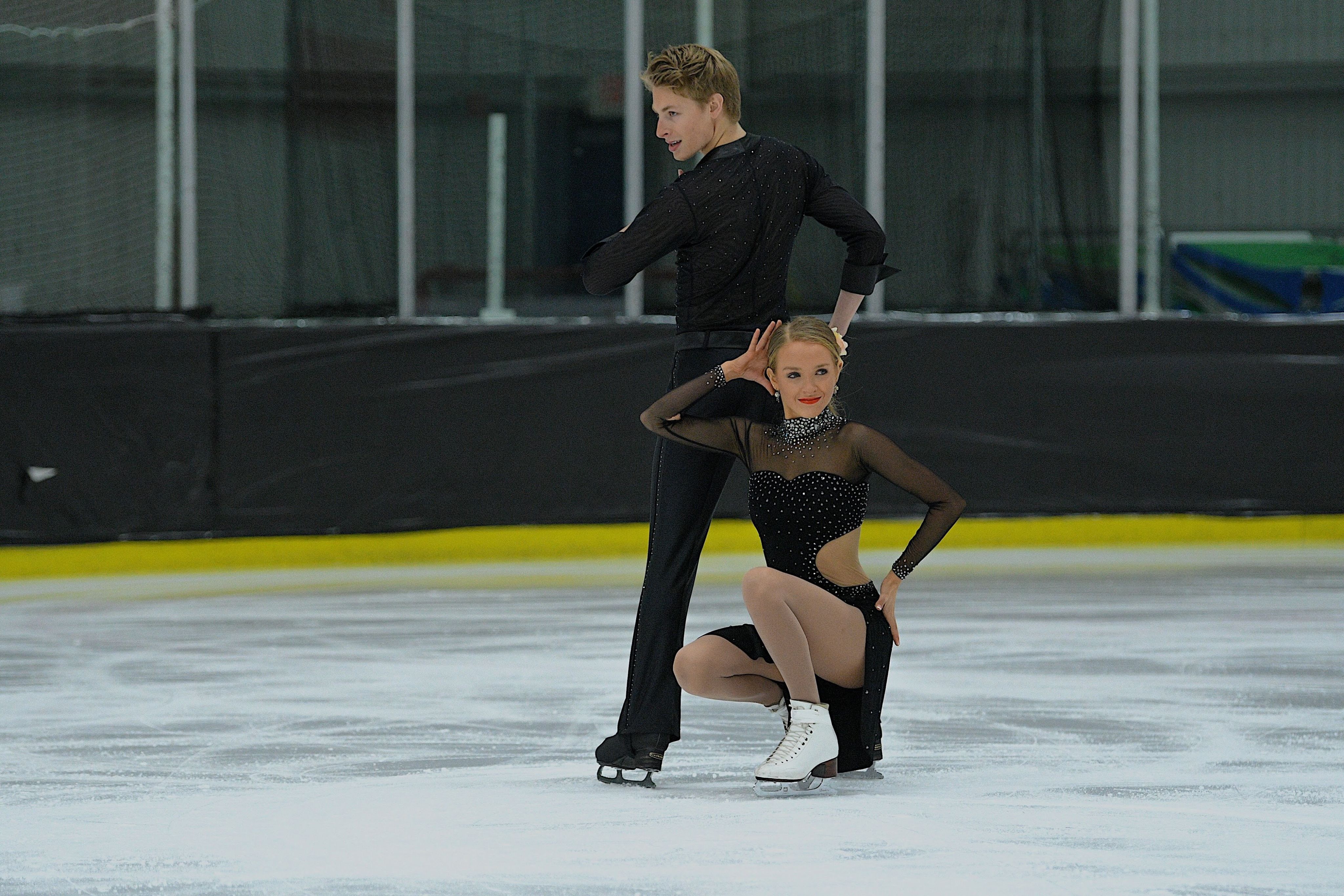
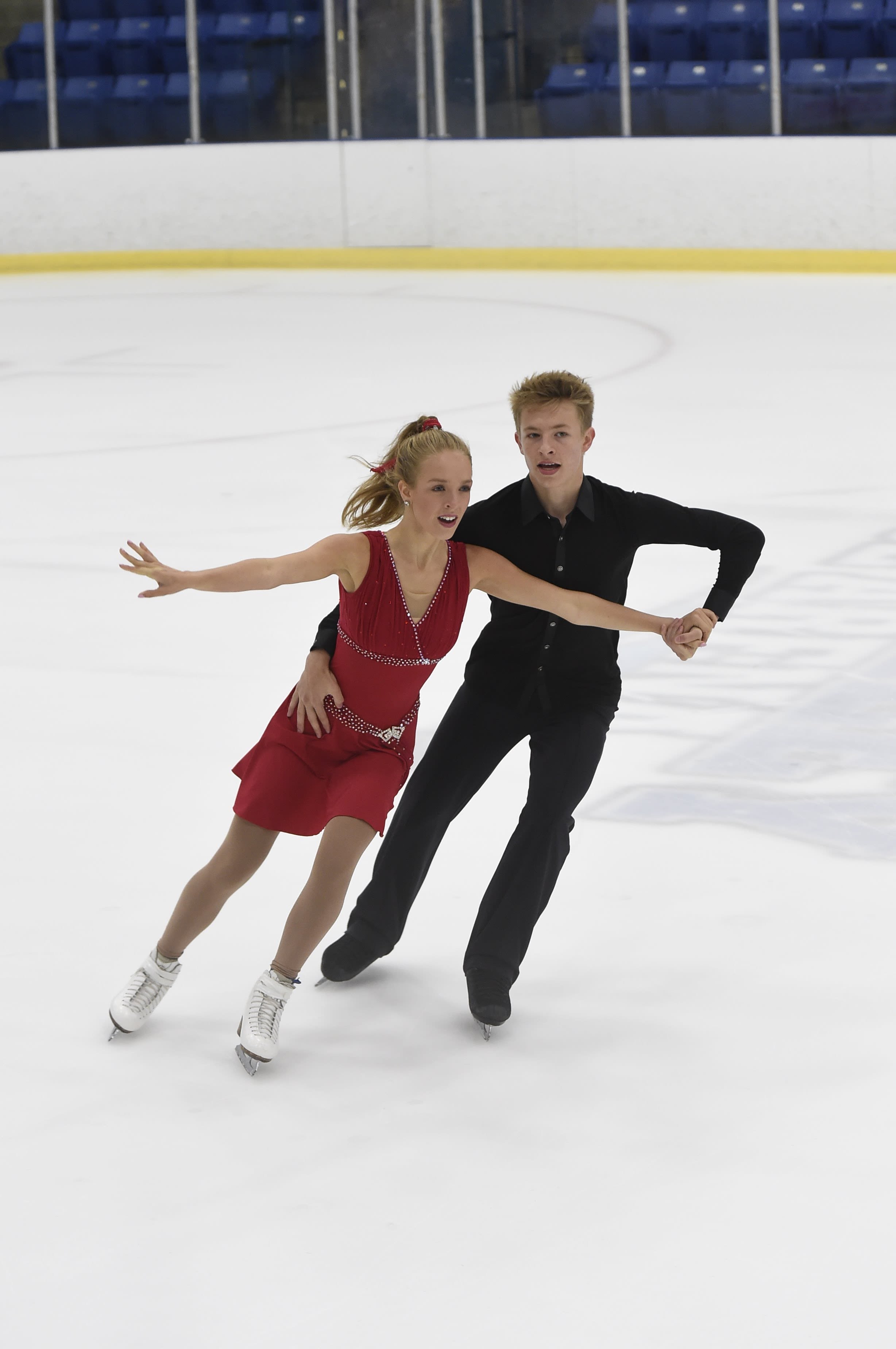
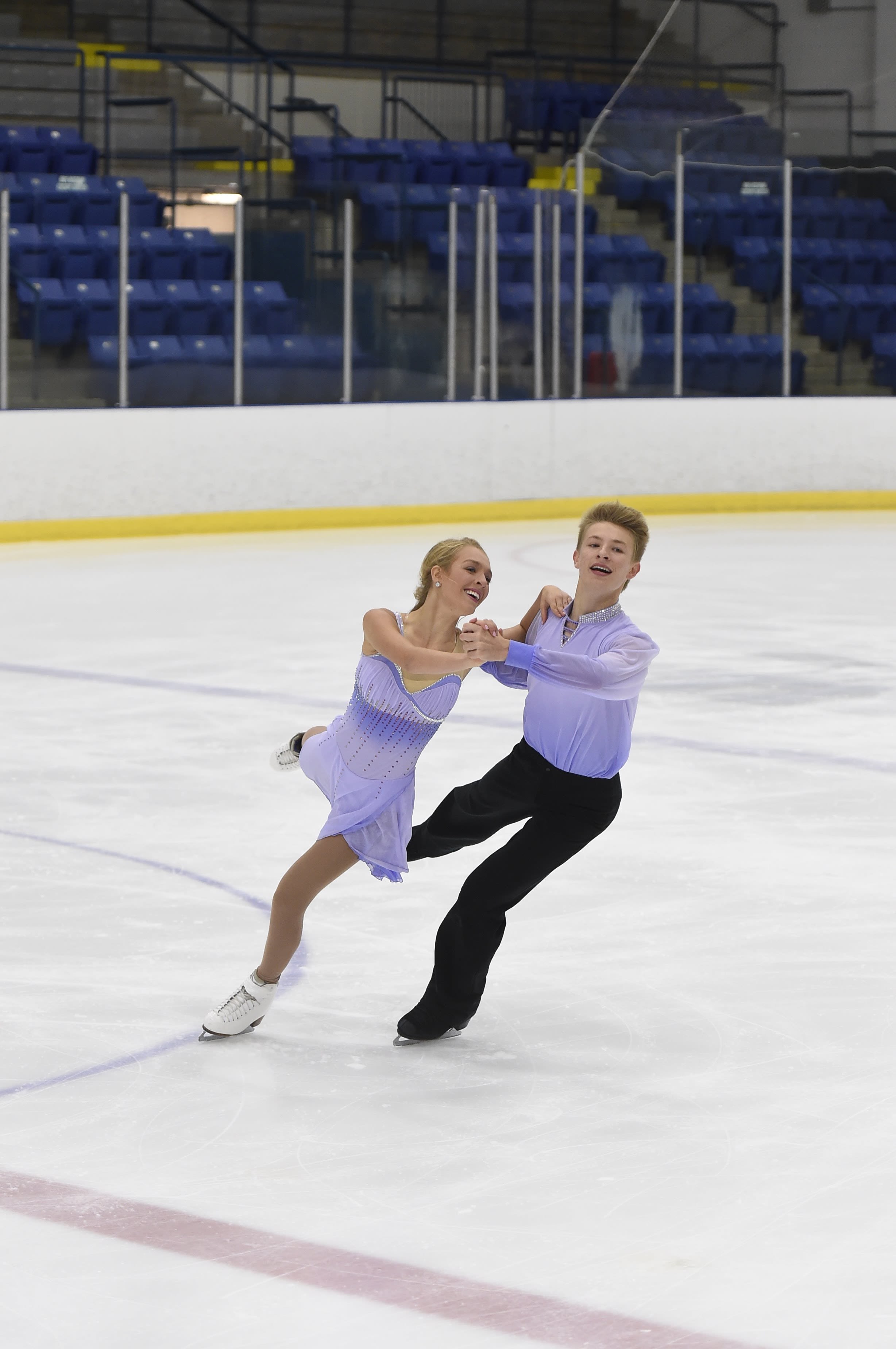

Claire and her brother, Luke, at the 2018 Midwestern Sectionals, courtesy of Claire Purnell
Claire and her brother, Luke, at the 2018 Midwestern Sectionals, courtesy of Claire Purnell

Claire and her brother, Luke, at the 2016 Chicago Open, courtesy of Claire Purnell
Claire and her brother, Luke, at the 2016 Chicago Open, courtesy of Claire Purnell

Claire and her brother, Luke, at the 2016 Chicago Open, courtesy of Claire Purnell
Claire and her brother, Luke, at the 2016 Chicago Open, courtesy of Claire Purnell
As a competitive ice dancer in a large and very competitive training center, it was an unspoken fact that most of us were struggling with eating disorders or disordered eating. It was understood that the smaller we were as females, the higher rate of success we would achieve. Each of us took this on in our own ways; mine included fasting through our first on-ice session, a lot of black coffee and cardio on my rest days. I often wondered how long I could do it and, in the times I started to wonder if I could keep living like this, I would tell myself not to be a quitter. I had to be strong like everyone else that was fighting the same battle in order to succeed.
The year I quit skating and chose my mental and physical health, I was not alone. Several other female ice dancers I knew personally retired that year as well. Many for the same reasons, including Rachel Parsons, former competitive ice dancer 2018 NHK Trophy Bronze Medalist and four-time silver medalist in the ISU challenger series. I talked to her about ending her ice dance career due to her battles with an eating disorder for this article.
Parsons described her experience opening up on social media after retiring.
“I was definitely worried what my coaches would think and what other people at my training center would think and the judges and officials because in my mind I had been struggling for so long, it felt like a failure to essentially just give up and admit that I wasn’t strong enough to keep doing what I’d been doing,” she said. “That was really just what was expected and I know people that are dealing with the same thing that is still competing today that are continuing to push through.”
Parsons is referring to the countless figure skaters who battle eating disorders their whole careers and have just accepted that it is what they need to do to succeed.
What is Actually Happening Off the Ice & Inside Skater's Heads
Gracie Gold is another widely known figure skater who speaks publicly about her eating disorder battles.
Gold talked to The New York Times about her eating issues leading up to the 2014 Olympic games, surviving off only “a tomato and coffee some days.”
“I almost created this other person,” Gold told The Times. “I wanted to be the most flawless, angelic, plastic, Barbie-doll-face human who … does all the right things and is sterling.”
Instead, Gold missed the podium by one place at Sochi, earning fourth in the lady’s event. She earned fourth again at the 2016 World Figure Skating Championships two years later, leaving her devastated and falling into another form of binge eating disorder.
There is an image to this sport unlike any other. Figure Skating is the most beautiful sport in the Olympics. Or at least that is what I have heard countless people say in my lifetime of telling people I am/was a figure skater. The sport has the grace, musicality, rhythm, and performance of dance and ballet. Simultaneously, this sport requires elite athleticism; balance, strength, speed, endurance, stamina, and precision.
Skaters are judged on every minuscule detail of every move they make. Their step sequences are judged based on the lean of their blades on the edge as well as the cleanliness of the mark this edge leaves on the ice. Jumps are judged based on the direction the skater's blade leaves the ice and comes back to the ice, as well as jump height and rotation speed. All spins must be a certain number of exact rotations while staying in one place and achieving several different positions and levels all in one element. Judges have videos they go back and watch after the performance to be able to score each element precisely using zoom and slow-motion features to pick out each tiny detail. All the while the skaters must not forget to make it look easy and seamless. Or else it makes the sport lose it's spark.
While achieving the grace, stamina, speed and precise detail of each move these skaters also have to fit a body image that is set for the sport. In pairs and ice dance, the women must be shorter than the man, in pairs by at least a foot. The woman must weigh significantly less than the man. Judges and coaches encourage this to make lifts easier, however, it is also to fit the image. The men must be strong, but not too bulky. If a team brings a different body dynamic to the ice, they’re expected to overcome it to meet the status quo.
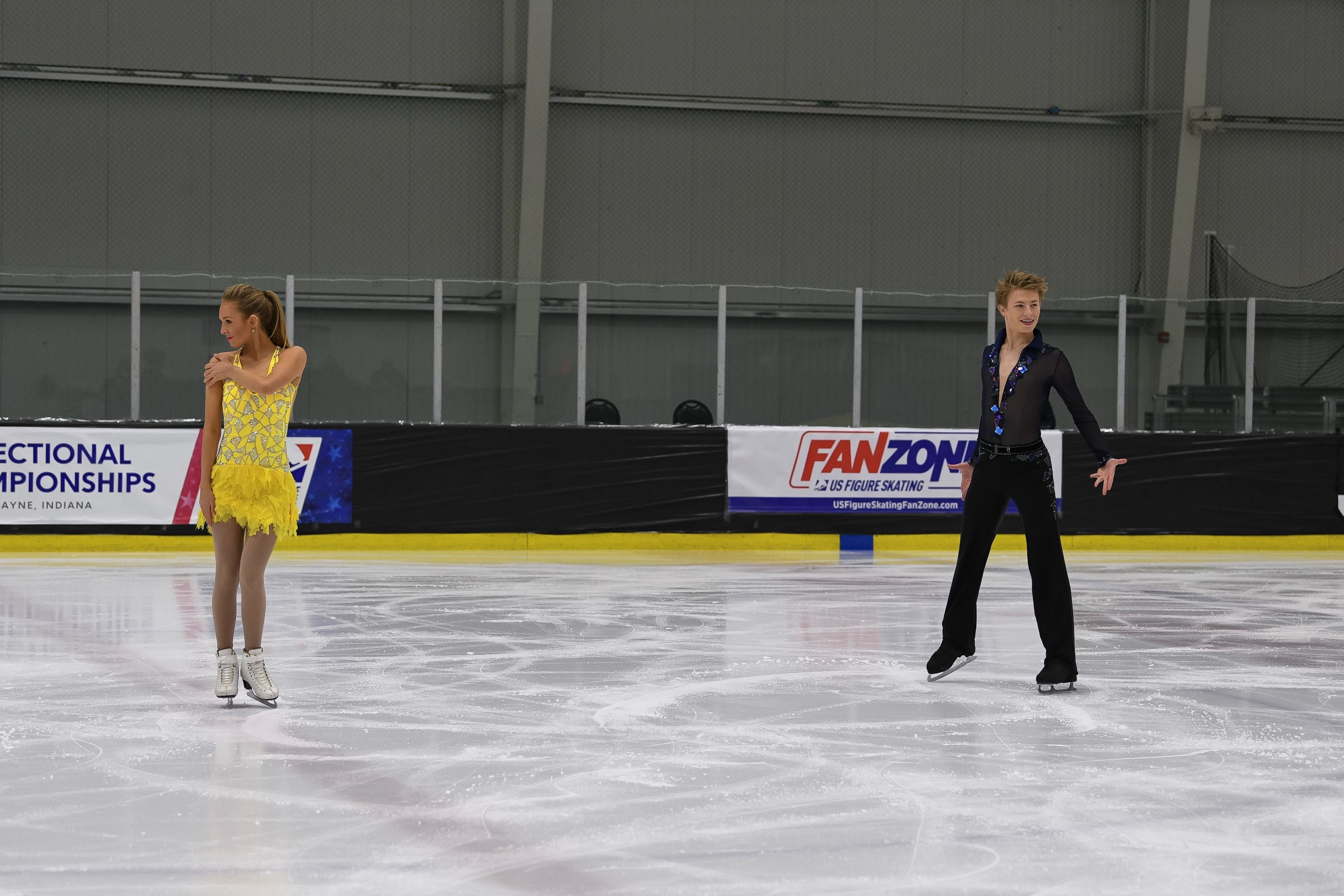
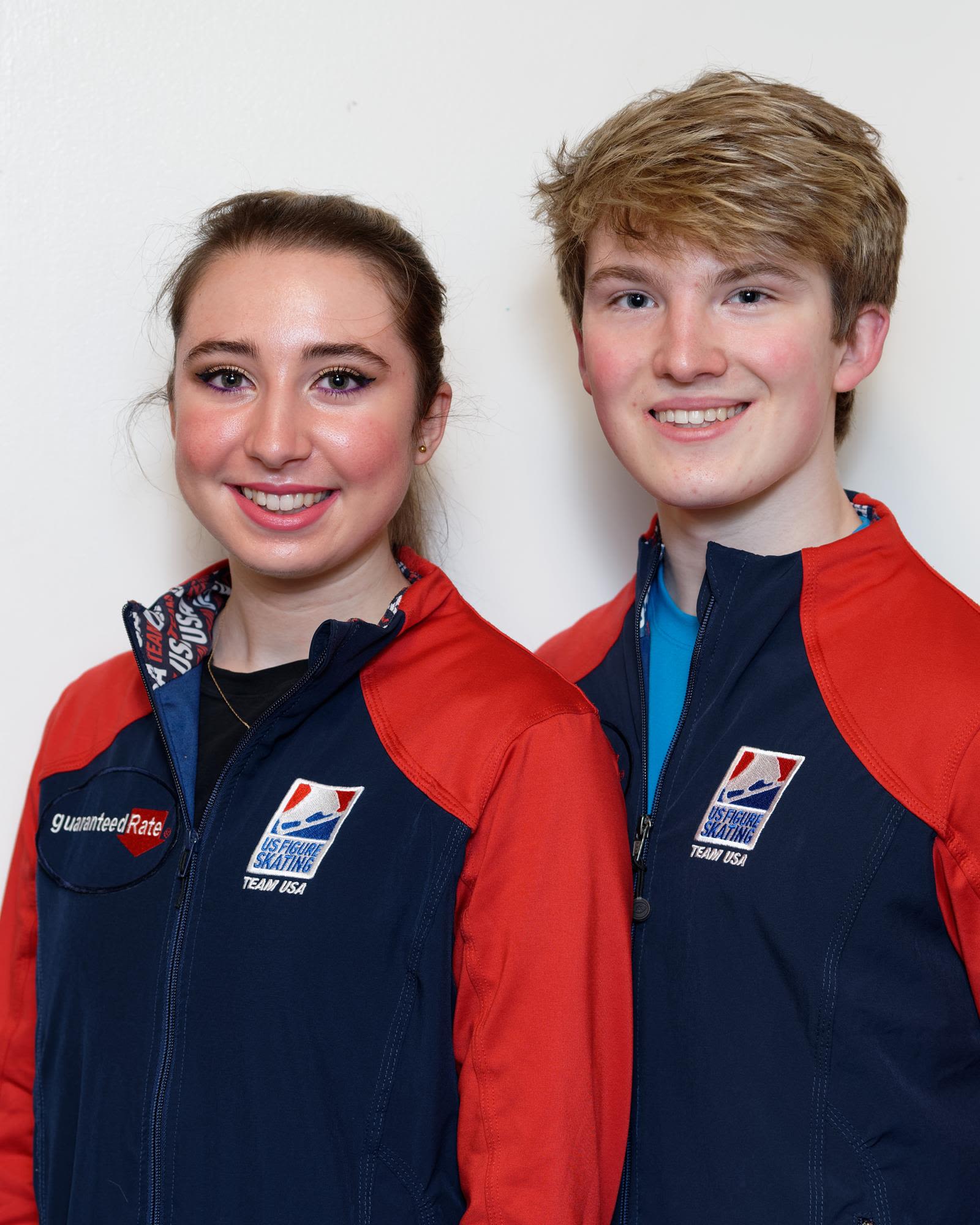
"Emily Bratti and Ian Somerville" (2021), courtesy of Fanzone: US Figure Skating
"Emily Bratti and Ian Somerville" (2021), courtesy of Fanzone: US Figure Skating
Some coaches took the more extreme approach, chastising their skaters and calling them names.
I talked with Emily Bratti about her experience with the mental and physical pressures placed on her as a female ice skater. Bratti skates with Ian Somerville and the team recently placed 5th at the U.S. Championships in the Senior level and members of Team USA Ice Dance.
Bratti spoke about her and Somerville’s prior training center before their recent switch in coaching teams.
“I felt like everything was against me. No matter what I did,” Bratti told me. “I was extremely stressed out and just constantly getting picked on and screamed at. it was just too much.”
I asked her what other circumstances pushed her away from such successful, well-known Ice Dance coaches.
“I don’t know how you survive that for so many years, just like constantly being told that like… you just look like a pig.” Bratti went on to say skaters were called other names and screamed at for their appearance regularly. Bratti was not sure what she would do but she knew she had to leave that training center.
Skating Was Going to Ruin My Life
In 2017 and 2018, Luke, my brother and former ice dance partner, and I attended conditioning sessions three times a week. In these sessions, the men were encouraged to lift very heavy weights. As they were strength training, the women were told to jump rope for 10 minutes, do sprints, or some form of cardio to ensure we stayed lean and did not become bulky. These sessions took place on the top floor of our training centers, looking out to the rink where all of my competitors and many of my role models were training. I was running off about 1,000 calories a day, but when I felt like the cardio would get the best of me, all I had to do was look out the window at my goals, and I could always push a little harder.
When I look back now, I am not sure if looking at my competitors and role models is what pushed me the extra mile. I think what I really looked at was my coaches. Can they see how hard I’m working up here? I hope they notice my stamina improving on the ice. I hope they are proud of me.
It was a random day at the end of June when I realized this sport would ruin my life. Every June, some of the best ice dance teams in the United States travel to Laurel, Maryland, for U.S. Dance Camp.
The day started early in the morning. Luke and I arrived at the Gardens Ice House close to 6:00 a.m. We first took to the ice with a group drills lesson. Dance Camp had fun times with my friends up until this year. This year, we were beginning to score higher, winning medals, working all morning and evening at our home rink, and we finally had something to prove. We were no longer “the girl who lifted the boy” or the team who couldn’t do the lifts. I made sure of that.
On that morning in June, one of the tasks we had to complete was a fitness assessment. We changed into our matching camp shirts and left for the off-ice arena for Standardized Testing of Athleticism to Recognize Skaters, or S.T.A.R.S. Each athlete goes through a series of fitness tests alone with just their water bottles and a piece of paper to record technical scores and, the evaluation I dreaded most each year, the one on our bodies.
Our height and weight were the first metrics recorded on that sheet of paper that we had to carry with us all day. If I was not careful, my teammates could see my results, so I made sure to turn this paper over at every station I went to so that no one could see my weight. I learned this during the first year that I attended this camp, at age 11. The burning shame that engulfed my whole body when anyone saw those numbers was enough to make me dread dance camp each year.
This specific year, my weight was the lowest it had ever been. I was 16 years old, and this was my 5th time at this camp. I weighed in at 10 pounds underweight. But I still hid the number. I still wasn’t small enough.
After testing, we got back on the ice to work with the judges. Some of the most esteemed judges in U.S. Figure Skating were there to work with us to improve our dances before the competition season began.
That was the first time anyone had acknowledged my significant weight loss to my face. At the time, the most influential U.S. Ice Dance judge looked me in the eyes in front of my brother and my coach, whom I would do anything to please, and said she had noticed my weight and congratulated me on taking care of myself and getting serious about the sport. I had lost 35 pounds that year. I was 16 years old, battling anorexia and exercise bulimia, and the only acknowledgment I got from all of the people I wanted to please most was, “Congratulations.”
After that painful realization, I could never see the sport in the same way.
The day was full of comparison and competition for attention and recognition. No one was scored. No one earned a medal from this camp. We were all there to learn and improve as a team - Team USA Ice Dance. Except for the fact that everyone knew there were winners and losers. The judges had favorites. Politics became a little bit more obvious. All I could do was be perfect so that, maybe, we would stand out. Perhaps, our hard work would finally be acknowledged. Maybe all the pressure I put on myself, the pain I endured, and the drastic measures I took to succeed would be noticed.
“I was afraid people would see me as weak for admitting that,” Parsons said when she recalled making her retirement from ice dancing public due to needing treatment for her eating disorder. “It’s also bad optics for the sport to have athletes retiring from eating disorders that are the result of the sport.”
It’s no secret that so many female figure skaters struggle with these issues anymore. U.S. Figure skating has lost its status in the women's event. If nothing changes, will women's figure skating ever be competitive again?
I think there is hope. There is a reason why Emily Bratti loves this sport and is still representing our country at the highest level.
Bratti told me, “I would like to think that the sports changing, and I think it is. … At least in the environment I’m in now. Compared to before it’s just incredible."
Then she said something that stuck with me, “If it is changing, it’s only because of the skaters. It’s not because of any officials or coaches. … I think it’s because the skaters who are coming out and sharing their stories and inspiring other people.”
People like Rachel Parsons who shared her story are making a difference among the skaters. This is huge. However, when the sport still revolves around the decisions of judges and the instructions of coaches, it makes it insanely difficult for the skaters to create change. It needs to start at the top, with the coaches and judges.
I spoke to Angie Asche, a sports dietician for professional athletes including U.S. Figure Skaters. Angie was also my sports nutritionist while I was still competing.
Asche said she worked with about 20-30 skaters; male and female and out of every single one she has worked with there have been eating disorders or disordered eating. She has heard things like how they would hide in the bathroom so their coaches didn’t see them eat - even just an apple or banana.
“It all stems back to judges and coaches,” Asche said. “It’s not really so much what can the skaters do, I think it’s more so on the entire industry as a whole; how can we educate both the coaches and the judges, that picking apart all these tiny, little nit-picky details about somebody's body size is doing more harm than good?”
Going forward: “We’re going to have a very young skating industry where 15/16 year olds are quitting because they can't handle it mentally. I think if there’s a way we can educate the coaches and the judges on trying to judge on other aspects besides just their weight then that’s where change can come from."
It’s pretty apparent that the change needs to start at the top to be able to make a difference. From Asche’s scientifically educated sports dietician perspective, those five or 10 pounds these coaches are berating their athletes on will not make a difference in their performance.
“The coaches are going to be the hardest part because culturally, especially from countries like Russia, it’s something that’s been ingrained in their practices for so long it would be very hard to tell them to not preach on an athlete's weight, but it’s so necessary.”
Asche wishes these coaches would be more aware of the risk of eating disorders in their athletes that would cause a way more significant decrease in their performance ability than the perceived “extra weight” they are chastising them for.
Figure skating doesn't have the privilege that other sports have of being a college sport with educated staff members who know how to talk to women about their weight and who to direct these athletes to if these issues arise. In college sports like volleyball, the coaches and officials go to training regarding these issues as they do in many sports, but the difference is how the people at the top treat these issues and their athletes. Asche thinks more education is needed for coaches and officials altogether so they are all on the same page is necessary for a change to be made.
This old-fashioned, waif-like female figure skater has been the image for female skaters since the 1900s. “I would like to think the skating world is coming to understand that being more muscular is better,” Bratti said. “Even though it’s not as what used to be treated as ideal."
Asche says her quick solution to so many females starving themselves to be lifted easier, or be the tiny little princess people’s eyes are drawn to, isn’t these women starving themselves. Some would argue that being smaller makes these athletes more aerodynamic and in the case of ice dance or pairs where the female is being lifted, lighter for the man to pick them up.
Asche’s solution is, “Get the guys to be stronger. Get them in the gym! So that the women don’t have to starve themselves to be thin.” She added, “Hopefully that stronger physique is becoming a little bit more widespread and the knowledge that the stronger an athlete is and the more they fuel their body, the better they will perform."
When I worked with Asche back in my competitive ice dance career we worked together to get me to feel like I was allowed to fuel my body. It was 2017 when we started working together and I had been battling anorexia nervosa and exercise bulimia for about two years at that point. These issues stemmed from me doing whatever I could to succeed in the sport; trying to please those judges and my coaches so that we could move up in the rankings. Angie would always remind me how to fuel and being stronger would enhance our performance and I would always leave our meetings feeling like a weight was lifted off my shoulders. I could be healthy again AND succeed. However, it would always only take a few days for my coaches or officials and judges to plant ideas in my head that would undo all the positive reinforcement she would give me in our meetings.
“The hardest thing about my job is I can only do so much in our meetings, but who are you around 24/7 when you get to the rink?” Asche said on our call.
What Asche and others continually told me in these interviews is the skaters are trying to find the help of counselors, nutritionists, dieticians, and therapists, but unless the coaches are educated, these mental battles are going to continue to drive skaters away from this sport. No matter how hard they fight to make figure skating a sustainable sport for athletes to enjoy and stay healthy as they compete, it cannot change if it doesn’t start to change at the top.
Many competitive figure skaters end their competitive careers and become coaches and officials. Since many of the current competitive skaters are trying to start the change among themselves, it may be that their generation of coaches will be the ones who change the sport and the body ideals for good.
